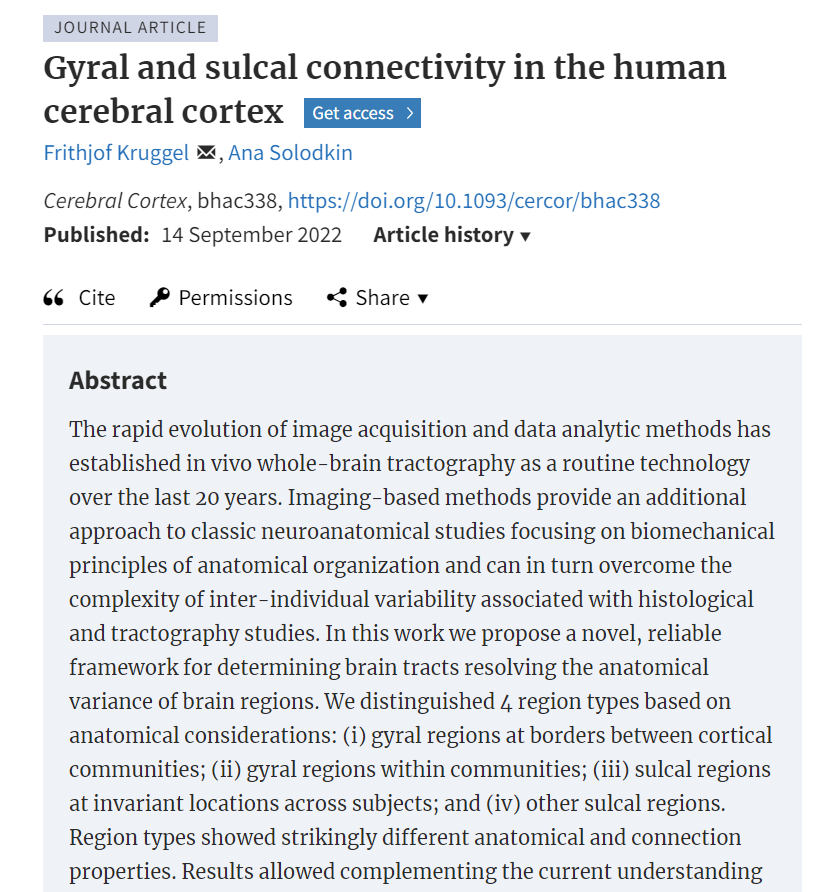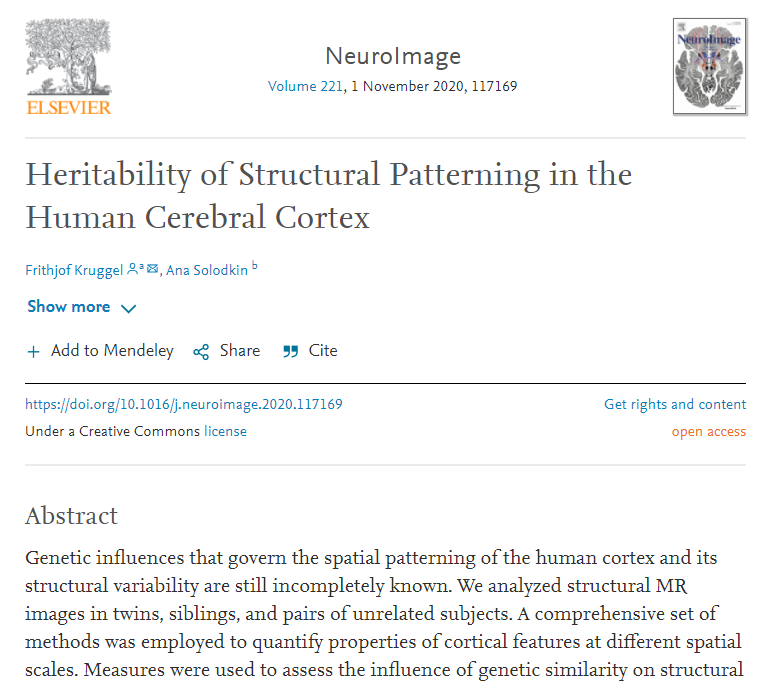Publications
Group highlights
(For a full list of publications and patents see below or go to Google Scholar(Dr. Solodkin), Google Scholar(Dr. Small) and Google Scholar(Dr. Sharma).

The rapid evolution of image acquisition and data analytic methods has established in vivo whole-brain tractography as a routine technology over the last 20 years. Imaging-based methods provide an additional approach to classic neuroanatomical studies focusing on biomechanical principles of anatomical organization and can in turn overcome the complexity of inter-individual variability associated with histological and tractography studies. In this work we propose a novel, reliable framework for determining brain tracts resolving the anatomical variance of brain regions. We distinguished 4 region types based on anatomical considerations: (i) gyral regions at borders between cortical communities; (ii) gyral regions within communities; (iii) sulcal regions at invariant locations across subjects; and (iv) other sulcal regions. Region types showed strikingly different anatomical and connection properties. Results …
Frithjof Kruggel, Ana Solodkin

Modeling is now recognized as an essential tool for studying one of the most complex structures known: the human brain. Since the seminal work of Wilson and Cowan in 1970s, who introduced the first neural mass model, much effort has been dedicated to understanding the brain dynamics and elucidating their intricate relation to neurodegenerative diseases or other aging-related brain disorders. Advances in Neurosciences have been driven by the vertiginous growth in all aspects of multi-omic data: genetic, epigenetic, transcriptomics, connectomics, exposomics, and phenomics. The continuous growth in computational resources has matched such overwhelming amounts of data. Since the phenomena/processes linked to diseases and/or brain disorders occur at different time-space scales, complex multi-scale models were needed and developed. A cornerstone of Brain modeling is high-dimensional …
Jorge Gulín-González, Maria L Bringas-Vega, Eduardo Martínez-Montes, Petra Ritter, Ana Solodkin, Mitchell Joseph Valdes-Sosa, Pedro Antonio Valdes-Sosa
Front Neuroinform. 2022; 16, 937790.

We use PET and magnetic resonance imaging (MRI) data from 33 participants of the Alzheimer’s Disease Neuroimaging Initiative (ADNI3) combined with frequency compositions of TVB-simulated local field potentials (LFP) for ML classification. The combination of empirical neuroimaging features and simulated LFPs significantly outperformed the classification accuracy of empirical data alone by about 10% (weighted F1-score empirical 64.34% vs. combined 74.28%). Informative features showed high biological plausibility regarding the AD-typical spatial distribution.
Paul Triebkorn, Leon Stefanovski, Kiret Dhindsa, Margarita‐Arimatea Diaz‐Cortes, Patrik Bey, Konstantin Bülau, Roopa Pai, Andreas Spiegler, Ana Solodkin, Viktor Jirsa, Anthony Randal McIntosh, Petra Ritter, Alzheimer’s Disease Neuroimaging Initiative
Alzheimer and Dementia Translational Research and Clinical Interventions, 8.,1., e12303

Genetic influences that govern the spatial patterning of the human cortex and its structural variability are still incompletely known. We analyzed structural MR images in twins, siblings, and pairs of unrelated subjects. A comprehensive set of methods was employed to quantify properties of cortical features at different spatial scales.
Frithjof Kruggel, Ana Solodkin
NeuroImage, Volume 221, 1 November 2020, 117169

The Virtual Brain (TVB), to effectively model individualized brain activity, enabling the linkage of large-scale (macroscopic) brain dynamics with biophysical parameters at the meso- and microscopic levels. The remarkable consistency of changes in modeling parameters in our studies points toward feasibility to identify potential biomarkers associated with individual physiopathology in stroke and neurodegeneration.
Ana Solodkin, Joelle Zimmermann, Anthony R McIntosh, Leon Stefanovski, Petra Ritter
Molecular-Genetic and Statistical Techniques for Behavioral and Neural Research, 2018, Pages 3-30

Alzheimer’s disease (AD) is marked by cognitive dysfunction emerging from neuropathological processes impacting brain function. AD affects brain dynamics at the local level, such as changes in the balance of inhibitory and excitatory neuronal populations, as well as long-range changes to the global network. Individual differences in these changes as they relate to behaviour are poorly understood. Here, we use a multi-scale neurophysiological model, “The Virtual Brain (TVB)”, based on empirical multi-modal neuroimaging data, to study how local and global dynamics correlate with individual differences in cognition. In particular, we modeled individual resting-state functional activity of 124 individuals across the behavioural spectrum from healthy aging, to amnesic Mild Cognitive Impairment (MCI), to AD. The model parameters required to accurately simulate empirical functional brain imaging data correlated significantly with cognition, and exceeded the predictive capacity of empirical connectomes.
Joelle Zimmermann, Alistair Perry, Michael Breakspear, Michael Schirner, Perminder Sachdev, Wei Wen, Nicole A Kochan, Michael Mapstone, Petra Ritter, Anthony R McIntosh, Ana Solodkin
NeuroImage:Clinical, Volume 19, 2018, Pages 240-251
Full List of publications
Gyral and sulcal connectivity in the human cerebral cortex
Frithjof Kruggel, Ana Solodkin
Cerebral Cortex, bhac338
Brain Modeling of Neurogenerative Disorders
Jorge Gulín-González, Maria L Bringas-Vega, Eduardo Martínez-Montes, Petra Ritter, Ana Solodkin, Mitchell Joseph Valdes-Sosa, Pedro Antonio Valdes-Sosa
Front Neuroinform. 2022; 16, 937790.
Brain simulation augments machine‐learning–based classification of dementia
Paul Triebkorn, Leon Stefanovski, Kiret Dhindsa, Margarita‐Arimatea Diaz‐Cortes, Patrik Bey, Konstantin Bülau, Roopa Pai, Andreas Spiegler, Ana Solodkin, Viktor Jirsa, Anthony Randal McIntosh, Petra Ritter, Alzheimer’s Disease Neuroimaging Initiative
Alzheimer and Dementia Translational Research and Clinical Interventions, 8.,1., e12303
Bridging scales in Alzheimer’s disease: Biological framework for brain simulation with The Virtual Brain
Leon Stefanovski, Jil Mona Meier, Roopa Kalsank Pai, Paul Triebkorn, Tristram Lett, Leon Martin, Konstantin Bülau, Martin Hofmann-Apitius, Ana Solodkin, Anthony Randal McIntosh, Petra Ritter
Front. Neuroinform., 01 April 2021
One season of head-to-ball impact exposure alters functional connectivity in a central autonomic network
Derek C Monroe, Robert S Blumenfeld, David B Keator, Ana Solodkin, Steven L Small
NeuroImage, Volume 223, December 2020, 117306
Heritability of Structural Patterning in the Human Cerebral Cortex
Frithjof Kruggel, Ana Solodkin
NeuroImage, Volume 221, 1 November 2020, 117169
Linking molecular pathways and large-scale computational modeling to assess candidate disease mechanisms and pharmacodynamics in Alzheimer’s disease
Leon Stefanovski, Paul Triebkorn, Andreas Spiegler, Margarita-Arimatea Diaz-Cortes, Ana Solodkin, Viktor Jirsa, Anthony Randal McIntosh, Petra Ritter, for the Alzheimer’s Disease Neuroimaging Initiative
Front. Comput. Neurosci., 13 August 2019
Neurological biomarkers and neuroinformatics: the role of the virtual brain
Ana Solodkin, Joelle Zimmermann, Anthony R McIntosh, Leon Stefanovski, Petra Ritter
Molecular-Genetic and Statistical Techniques for Behavioral and Neural Research, 2018, Pages 3-30
Differentiation of Alzheimer’s disease based on local and global parameters in personalized Virtual Brain models
Joelle Zimmermann, Alistair Perry, Michael Breakspear, Michael Schirner, Perminder Sachdev, Wei Wen, Nicole A Kochan, Michael Mapstone, Petra Ritter, Anthony R McIntosh, Ana Solodkin
NeuroImage:Clinical, Volume 19, 2018, Pages 240-251